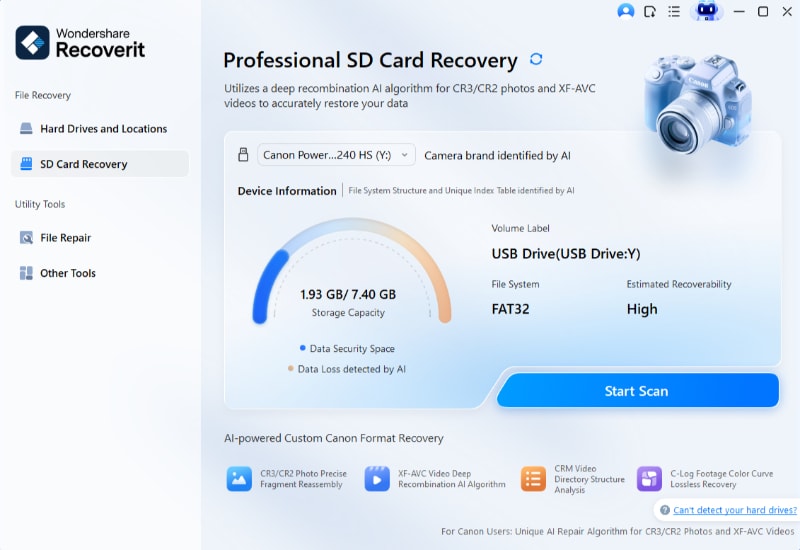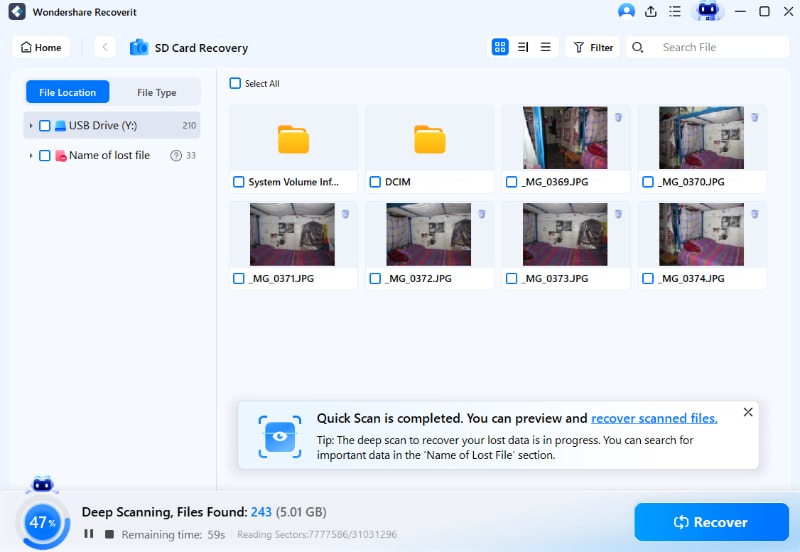SD cards are mainly used for small cell phones, notebooks and digital cameras. When you start using Windows on your computer, you may encounter several issues with it. Therefore, one of the easiest ways to solve this problem would be to get a bootable SD card.
A bootable SD card will allow you to quickly boot Windows from the SD card without encountering any significant problems. The bootable SD card contains a bootable operating system. However, it may sometimes fail to read by the device because of compatibility issues. After all, different devices support different file systems.
One of the best things to do in this case would be to format bootable SD card. You can adopt different methods to format the SD card and prevent the chances of running into any major problems. This blog explores all the potential techniques for how to format bootable SD card.
Worried for Data from Formatted SD Card, Try Wondershare Recoverit to Perform Data Recovery

In this article
Reasons to Format Bootable SD Card
The SD card is a special memory card, which may only be compatible with a few devices for different users. The bootable SD card is a type of special card that can run seamlessly across cameras, phones and more. The bootable SD card will allow the computer to boot with bootable issues.
Some of the key reasons to format bootable SD card are as follows:
- Different devices read different kinds of SD cards. Therefore, it is advisable to format bootable microSD card into an accepted file system for the respective system.

- Bootable SD cards may be prone to errors, and corruption. However, formatting the same can play an essential role in preventing the risk of these errors thereby increasing the lifespan of the card.
- Sometimes, the bootable SD card may not fit your computing requirements. Therefore, you can format bootable SD card to fix this issue.
How to Format a Bootable SD Card?
Formatting a bootable SD card is one of the easiest ways to fix the error. When you format the bootable SD card, it becomes free of all the existing files and mistakes. As a result, the SD card will appear to be new, which can be helpful for using it in a new system again.
Some of the key steps to format the bootable SD card are as follows:
Solution 1. Format Bootable SD Card with File Explorer
One of the easiest ways to format the bootable SD card is to use Windows File Explorer. Since Windows File Explorer is already available in the system, it is easier to access. Therefore, with a few clicks, you can format a bootable SD card with File Explorer in no time.
You may follow the steps given below to format bootable SD card using File Explorer:
Step 1: Using a card reader, connect the SD card to the computer.
Step 2: Navigate to This PC on your system. Now, you have to browse for the SD card that you want to format. Once located, right-click on the SD card and from the drop-down menu, choose Format.

Step 3: You will receive a new label option wherein you have to mention all details of the SD card such as file system, and volume label. Select the Quick Format option and hit the Start button.

Step 4: You will now receive a warning message stating that formatting the bootable micro SD card will remove all data. Click on OK to continue with the process.

Solution 2. Format Bootable SD Card with Disk Management
If the above methods do not work, choosing the Disk Management feature to boot micro SD is advisable. This in-built system allows you to get into formatting seamlessly without any delay.
Follow the steps below to format bootable micro SD card using the Disk Management feature in your PC:
Step 1: Get a good-quality card reader, insert your SD card into it and then connect it to your computer.
Step 2: Navigate to This PC and right-click on it. From the given option, choose Manage and then enter the Disk Management section.

Step 3: Look for the SD card that you want to format. Right-click on it and choose the Format option.

Step 4: Now, hit the Yes button and customize the details like file system, new label and more for the card. Once that is done, click the OK option to continue formatting.

Bonus Tip - How to Create a Bootable SD Card
Now that you know how to format a bootable SD card, you must also learn how to create one. For this purpose, you will need to take an extra step, which is to download Rufus. Once you have Rufus in your system, creating a bootable SD card will be very easy.
Below are the steps to create bootable micro SD card using Rufus:
Step 1: Visit the official website of Rufus and download it on your system. Once the file is downloaded, install it.
Step 2: Launch Rufus by clicking on the “Run as Administrator” option.

Step 3: From the device drop-down menu, select the SD card. The default file system should be around FAT32.
Step 4: Once you enter all the details, click on the Quick Format box and then create the bootable disk. For that, click on the Windows 10 ISO file to create a bootable micro SD.

Step 5: Hit the start button and wait for a few minutes for the process to complete.

Recover SD Card Lost Data Using Recoverit SD Card Recovery
One of the best tools for SD card data recovery is Wondershare Recoverit. While Wondershare Recoverit doesn't help format the SD card, it plays an important role in recovering data from the formatted SD card. To initiate the process, you must download and install Wondershare Recoverit on your device.
Wondershare Recoverit is compatible with numerous devices, which adds the advantage of easy data recovery. Moreover, since it supports different formats and file systems, it becomes easier to recover data. Now, the benefits will be endless if you start using the premium version. So, you can install Recoverit data recovery software in your system as soon as possible to initiate the data recovery process.
Wondershare Recoverit is available for free for macOS and Windows OS devices. Once you have installed Wondershare Recoverit on your device, connect the SD card to your system with a card reader and begin the data recovery.
Step 1: Connect and Select the SD Card
Launch Wondershare Recoverit data recovery software on your computer. Select the SD card from which you want to recover the data under the File Recover option. Click on the Scan button present next to it.

Step 2: Scan the Micro SD Card
Wondershare Recoverit will begin scanning the SD card to look at all the deleted and lost data. Once the first scan is done, you can see the files. If you don't, you will have to conduct a Deep Scan. The Deep Scan mode allows more files from the SD scan to be recovered.

Step 3: Preview and Recover the SD Card Data
After the deep scan of the SD card is complete, all the lost or hidden data should be available in the Wondershare Recoverit main option button. Now, click on each file and check for the data you want to recover. Preview and click the Recover button for the data you want to recover.

Conclusion
You must know how to format bootable SD card to avoid any major risks. It is advisable to look into the basic features and adopt the necessary methods through which you can easily boot the SD cards. These methods will be one of the best ways to stay ahead in the business and bring in the best results. However, make sure to back up the data using a reliable data recovery tool to prevent the risk of major data loss.
FAQ
-
1. How do I format a bootable SD card?
You can format bootable SD card from the in-built systems in your device itself. For this purpose, you may use Windows Disk Management or Windows File Explorer. -
2. Is it possible to make a bootable SD card?
Yes, you can make a bootable SD card. However, you will need to take an additional step: download and install Rufus in your system to proceed with it. -
3. How do I format a dead SD card?
You can format the dead SD card using Windows File Explorer. In order to do this, you must insert the dead SD card into the system using a card reader. If your system doesn't work, you may use third-party software, too. -
4. How to format a SD card using cmd?
You need to run Command Prompt as an administrator in Windows to format the SD card. It is advisable to enter all the details and formatting details appropriately as a command with the correct SD card number for formatting the SD card using the cmd prompt.




 ChatGPT
ChatGPT
 Perplexity
Perplexity
 Google AI Mode
Google AI Mode
 Grok
Grok























